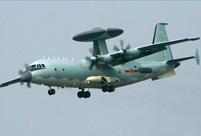

Computer users, publishing houses also embrace the typefaces based on murals, historical stamps and more
The Qomolangma-Horyig font, a popular typeface among the Qomolangma Tibetan fonts, was once reserved for the seals of imperial families and living Buddhas. (Photo/CHINA DAILY)
The release of brand-new Qomolangma Tibetan fonts by the China Tibetology Research Center means the iPhone is no longer the only mainstream option for Tibetans who want a smartphone that can display their language.
Tibetan-speaking users can download the fonts from the Internet and personalize their smartphones by choosing their favorite fonts from among 17 typefaces. Previously, only Uchen, the classic block-style Tibetan script, was offered.
The fonts have quickly been adopted by computer users and publishing houses as well.
The technical advances achieved by Tibetan researchers over the course of eight years have made digital Tibetan stylish, said Norgye, director of the Information Center of the Minzu Publishing House, which released the new fonts in mid-November.
"It's like having only one set of clothing for a long time. Suddenly, you can dress up and pick whatever you want from the closet for different occasions. Such change is exhilarating to end users," Norgye said.
As at least eight of the fonts are based on the handwriting of famous Tibetan calligraphers, the Qomolangma fonts display the essence of Tibetan lettering design.
The breakthrough required overcoming many difficulties, as the rules related to handwritten Tibetan vary extensively, said Lu Yajun, of the Tibetology Institute at the Northwest University for Nationalities. The stroke of one vowel can extend over several words, for example, quite a challenge for digital media, he said.
"Compared with the previous stiff Tibetan fonts available, the new Qomolangma fonts are more flexible. With the stretched strokes, they often remind me of shadowboxing," Lu said.
Lu, who has studied Tibetan culture for decades, said he was impressed by the Tibetan people's passion for calligraphy. Tibetan children traditionally practice handwriting with a bamboo pen on a sand-covered plank to improve their writing skills before moving onto paper. A Tibetan idiom even likens a good author with poor handwriting to a warrior with a broken arm, he said.
To quench the public thirst for stylish Tibetan fonts in the digital world, the research center launched the government-funded project in 2007.
An expert panel was organized to decide the style of each font so that the Qomolangma fonts could meet the aesthetic preferences of Tibetans in different regions, said Tashi Tsering, a researcher who led the project.
The other three fonts among the 17 typefaces offered by the Qomolangma Tibetan fonts by the China Tibetology Research Center. (Photo/CHINA DAILY)
 |
 Beautiful skiers wear shorts in snow
Beautiful skiers wear shorts in snow Getting close to the crew on China's aircraft carrier
Getting close to the crew on China's aircraft carrier Chinese stewardess celebrate test flight at Nansha Islands
Chinese stewardess celebrate test flight at Nansha Islands A beauty's dancing youth
A beauty's dancing youth "Rent me as your girlfriend!"
"Rent me as your girlfriend!" World's first 'underwater skyscraper'
World's first 'underwater skyscraper'  Top 10 weapons in the world in 2015
Top 10 weapons in the world in 2015 Are these the world’s scariest landing strips?
Are these the world’s scariest landing strips? In pics: Left behind children in China
In pics: Left behind children in China Top 20 hottest women in the world in 2014
Top 20 hottest women in the world in 2014 Top 10 hardest languages to learn
Top 10 hardest languages to learn 10 Chinese female stars with most beautiful faces
10 Chinese female stars with most beautiful faces China’s Top 10 Unique Bridges, Highways and Roads
China’s Top 10 Unique Bridges, Highways and Roads Doctor deceit
Doctor deceit Cash for trash
Cash for trash ‘AIDS village’ looks to the future after hundreds have died
‘AIDS village’ looks to the future after hundreds have died Foreigners having a hard time finding psychological help in China
Foreigners having a hard time finding psychological help in ChinaDay|Week